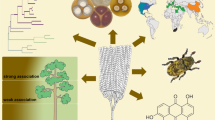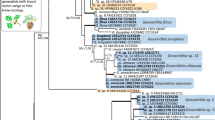Abstract
Geosmithia spp. (Ascomycota: Hypocreales) are little-studied, dry-spored fungi that occur in galleries built by many phloeophagous bark beetles. This study mapped the distribution and environmental preferences of Geosmithia species occurring in galleries of temperate European bark beetles. One hundred seven host tree samples of 16 tree species infested with 23 subcortical insect species were collected from across Europe during the years 1997–2005. Over 600 Geosmithia isolates from the beetles were sorted into 17 operational taxonomic units (OTUs) based on their phenotype similarity and phylogeny of internal transcribed spacer (ITS) region of rDNA (ITS1-5.8S-ITS2). The OTUs represent six known species and eight undescribed taxa. Ninety-two samples infested with subcortical insects were characterized by the presence/absence of OTUs and the similarity among the samples was evaluated. Geographically distant populations of the same beetle species host relatively uniform Geosmithia communities across large geographic areas (ranging from southern Bulgaria to the Czech Republic). This suggests effective dispersal of Geosmithia spp. by bark beetles. Clustering of similar samples in ordination analysis is correlated predominantly with the isolation source (bark beetles and their respective feeding plant), but not with their geographical origin. The composition of the Geosmithia OTU community of each bark beetle species depends on the degree of isolation of the species’ niches. Thus, Geosmithia communities associated with regularly co-occurring bark beetle species are highly similar. The similarity decreases with decreasing frequency of beetle species’ co-occurrence, a pattern resembling that of entomochoric ophiostomatoid fungi. These findings suggest that: 1) communities of Geosmithia spp. are vector-specific; 2) at least in some cases, the association between Geosmithia OTUs and bark beetles may have been very stable and symbioses are likely to be a fundamental factor in the speciation of Geosmithia fungi; and 3) that even nonsticky spores of Geosmithia are suitable for maintaining an insect–fungus association, contrary to previous hypotheses.




Similar content being viewed by others
References
Barras, SJ (1972) Improved White’s solution for surface sterilization of Dendroctonus frontalis. J Econ Entomol 65: 1504
Blackwell, M (1994) Minute mycological mysteries: the influence of arthropods on the lives of fungi. Mycologia 86: 1–17
Brändle, M, Brandl, R (2001) Species richness of insect and mites on trees: expanding Southwood. J Anim Ecol 70: 491–504
Burakowski, B, Mroczkowski, M, Stefańska, J (1992) Chrz1szcze—Coleoptera, Ryjkowcowate prócz ryjkowców—Curculionoidea prócz Curculionidae, Katalog Fauny Polski 51 (Pt 23, fasc 18). Muzeum i instytut zoologii PAN, Warszawa
Cannon, PF, Simmons, CM (2002) Diversity and host preference of leaf endophytic fungi in the Iwokrama forest reserve, Guyana. Mycologia 94: 2110–2220
Čížková, D, Šrůtka, P, Kolařík, M, Kubátová, A, Pažoutová, S (2005) Assessing the pathogenic effect of Fusarium, Geosmithia and Ophiostoma fungi from broad-leaved trees. Fol Microbiol 50: 59–62
Doganlar, M, Schopf, R (1984) Some biological aspects of the European oak bark beetle, Scolytus intricatus (Ratz) (Col, Scolytidae) in the northern parts of Germany (BRD). Z Angew Entomol 97: 153–162
Francke-Grosmann, H (1967) Ectosymbiosis in wood-inhabiting beetles. In: Henry SM (Ed.) Symbiosis. Academic Press, New York, pp 141–205
Freitag, H (1962) Einführung in die Biogeographie von Mitteleuropa unter besonderer Berücksichtigung von Deutschland. G. Fischer Stuttgart, Germany
Furniss, MM, Harvey, AE, Solheim, H (1990) Transmission of Ophiostoma ips (Ophiostomatales, Ophiostomataceae) by Ips pini (Coleoptera, Scolytidae) to ponderosa pine in Idaho. Ann Entomol Soc Am 88: 653–660
Gebhardt, H, Begerow, D, Oberwinkler, F (2004) Identification of the ambrosia fungus of Xyleborus monographus and X. dryographus (Coleoptera: Curculionidae, Scolytinae). Mycological Progress 3: 95–102
Harding, S (1989) The influence of mutualistic blue-stain fungi on bark beetle population dynamics. Royal Veterinary and Agricultural University Copenhagen, Copenhagen.
Harrington, TC, Rizzo, DM (1999) Defining species in fungi. In: Worrall JJ (Ed.) Structure and dynamics of fungal populations. Kluwer Academic Press, Dordrecht, Netherlands, pp 43–71
Harrington, TC (2005) Ecology and evolution of mycetophagous bark beetles and their fungal partners. In: Vega, FE, Blackwell, M (Eds.) Insect-fungal association, ecology and evolution. Oxford university press, New York, pp 257–291
Huelsenbeck, JP, Ronquist, F (2001) MRBAYES: Bayesian inference of phylogenetic trees. Bioinform 17: 754–755
Jankowiak, R, Hilszczanski, J (2005) Ophiostomatoid, fungi associated with Ips typographus (L.) on Picea abies [(L.) H. Karst.] and Pinus sylvestris L. in north-eastern Poland. Acta Soc Botan Polon 74: 345–350
Kennedy, CEJ, Southwood, TRE (1984) The number of species of insects associated with British trees: a re-analysis. J Anim Ecol 53: 455–478
Kirisits, T (2004) Fungal associates of European bark beetles with special emphasis on the ophiostomatoid fungi. In: Lieutier F (Ed.) Bark and wood boring insects in living trees in Europe, a synthesis. Kluwer Academic Publishers, pp 181–235
Kirschner, R (1998) Diversität Mit Borkenkäfern Assoziierter Filamentöser Mikropilze. Fakultät für Biologie. Eberhard-Karls Universität, Tübingen, p. 573.
Kirschner, R (2001) Diversity of filamentous fungi in bark beetle galleries in Central Europe. In: Misra, JK, Horn, BW (Eds.) In Trichomycetes and other fungal groups: Professor Robert W Lichtwardt Commemoration Volume Science Publishers, Enfield, (NH), USA, pp 175–196
Kirschner, R (2003) Two new species of Pyxidiophora associated with bark beetles in Europe. Mycological Progress 2: 209–218
Kolařík, M, Kubátová, A, Pažoutová, S, Šrůtka, P (2004) Morphological and molecular characterisation of Geosmithia putterillii, G. pallida comb. nov. and G. flava sp. nov., associated with subcorticolous insects. Mycol Res 108: 1053–1069
Kolařík, M, Kubátová, A, Čepička, I, Pažoutová, S, Šrůtka, P (2005) A complex of three new white-spored, sympatric, and host range limited Geosmithia species. Mycol Res 109: 1323–1336
Kolařík, M (2006) Host preference, taxonomy, diversity and host range of fungi associated with bark beetles with an emphasis on the genus Geosmithia in temperate Europe. Faculty of Science, Charles University in Prague, p. 133.
Kolařík, M, Sláviková, E, Pažoutová, S (2006) The taxonomic and ecological characterization of the clinically important heterobasiodiomycete Fugomyces cyanescens and its association with bark beetles. Czech Mycol 58: 81–98
Kolařík, M, Stodůlková, E, Šulc, P, Kuzma, M, Man, P, Flieger, M, Křesinová, Z (2006) Secondary metabolites in insect associated Geosmithia species: polyhydroxylated anthraquinones of G. lavendula and perspectives of future work. Book of abstracts; 10th International symposioum on the Genetics of Industrial Microorganisms, Prague, p. 181.
Kubátová, A, Novotný, D, Prášil, K (1999) Bělokaz dubový jako přenašeě mikroskopických hub [Oak bark beetle as vector of microscopic fungi]. In: Jankovský, L, Krejčíř, R, Antonín, V (Eds) Houby a les [Fungi and forest], Brno, pp 235–236.
Kubátová, A, Kolařík, M, Prášil, K, Novotný, D (2004) Bark beetles and their galleries: well-known niche for little known fungi, case of Geosmithia. Czech Mycol 55: 1–18
Kumar, S, Tamura, K, Nei, M (2004) MEGA3: integrated software for Molecular Evolutionary Genetics Analysis and sequence alignment. Brief Bioinform 5: 150–163
Lodge, DJ (1997) Factors related to diversity of decomposer fungi in tropical forests. Biodivers Conserv 6: 681–688
Malloch, D, Blackwell, M (1993) Dispersal biology of the ophiostomatoid fungi. In: Wingfield, MJ, Seifert, KA, Webber, JF (Eds.) Ophiostoma and Ceratocystis: taxonomy, ecology and phathogenicity. ABS Press, St. Paul, MN
Mueller, UG, Gerardo, NM, Aanen, DK, Six, DL, Schultz, TR (2005) The evolution of agriculture in insects. Annual Review of Ecology Evolution and Systematics 36: 563–595
Pfeffer, A (1994) Zentral-und westpaläarktische Borken-und Kernkäfer (Coleoptera: Scolytidae, Platypodidae)
Pfeffer, A, Knížek, M (1996) Coleoptera: Curculionoidea 2. In: Rozkošný R, Vaňhara, J (Eds.) Terrestrial Invertebrates of the Palava Biosphere Reserve of UNESCO, III. Fol Fac Sci Nat Univ Masarykianae Brunensis, Biologia, Brno, pp 601–607
Pitt, JI (1979) The genus Penicillium and its teleomorphic states Eupenicillium and Talaromyces. Academic Press, London
Pitt, JI (1979) Geosmithia gen. nov. for Penicillium lavendulum and related species. Can J Bot 57: 2021–2030
Pitt, JI, Hocking, AD (1997) Fungi and Food Spoilage, 2nd ed. Blackie Academic and Professional, London
Schroers, HJ, Geldenhuis, MM, Wingfield, MJ, Schoeman, MH, Yen, YF, Shen, WC, Wingfield, BD (2005) Classification of the guava wilt fungus Myxosporium psidii, the palm pathogen Gliocladium vermoesenii and the persimmon wilt fungus Acremonium diospyri in Nalanthamala. Mycologia 97: 375–395
Six, DL, Paine, TD (1999) Phylogenetic comparison of ascomycete mycangial fungi and Dendroctonus bark beetles (Coleoptera: Scolytidae). Ann Entomol Soc Am 92: 159–166
Six, DL (2003) Bark beetle–fungus symbioses. In: Bourtzis K, Miller TA (Eds.) Insect Symbiosis Contemporary Topics in Entomology. CRC Press, Boca Raton, London, New York, Washington D. C., pp 97–114
Solheim, H (1993) Fungi associated with the spruce bark beetle Ips typographus in an endemic area in Norway. Scand J For Res 8: 118–122
Solheim, H (1993) Ecological aspects of fungi associated with the spruce bark beetle Ips typographus in Norway. In: Wingfield MJ, Seifert KA, Webber JF (Eds.) Ceratocystis and Ophiostoma Taxonomy, Ecology and Pathogenicity. American Phytopathological Society, St Paul, MN, pp 235–242
ter Braak, CJF, Šmilauer, P (2002) Canoco reference manual and CanoDraw for Windows user’s guide. Software for Canonical Community Ordination (version 4.5), Microcomputer Power, Ithaca, NY, USA
Thompson, JD, Gibson, TJ, Plewniak, F, Jeanmougin, F, Higgins, DG (1997) The CLUSTAL X windows interface: flexible strategies for multiple sequence alignment aided by quality analysis tools. Nucleic Acid Res 25: 4876–4882
Whitney, HS (1982) Relationships between bark beetles and symbiotic organisms. In: Mitton JB, Sturgeon KB (Eds.) Bark beetles in North American conifers. University of Texas Press, Austin, pp 183–211
Wood, SL (1986) A reclassification of the genera of Scolytidae (Coleoptera). Gt Basin Nat Mem 10: 1–126
Acknowledgments
This project was supported by the Czech Sciences Foundation 522/02/1206, 206/03/H137, by the Ministry of Education, Youth and Sports institutional project MSM 0021620828, Institutional Research Concept AV0Z5020903 and grant No. MSM 6007665801, by the Grant Agency of the Czech Republic grant No. 206/03/H034, and by the Charles University Grant Agency grant 205/2004. We kindly thank Miloš Knížek (Forestry and Game Management Research Institute, Jíloviště-Strnady, Prague) for the bark beetle identifications. Special thanks go to David Novotný (Research Institute of Crop Production, Prague) for providing Geosmithia isolates from Ips typographus, to K. Nováková, R. Kirschner, P. Šrůtka, and many others for providing bark beetle samples or Geosmithia isolates. We also thank three anonymous reviewers for their valuable comments.
Author information
Authors and Affiliations
Corresponding author
Additional information
An erratum to this article can be found at http://dx.doi.org/10.1007/s00248-008-9371-1
Rights and permissions
About this article
Cite this article
Kolařík, M., Kubátová, A., Hulcr, J. et al. Geosmithia Fungi are Highly Diverse and Consistent Bark Beetle Associates: Evidence from their Community Structure in Temperate Europe. Microb Ecol 55, 65–80 (2008). https://doi.org/10.1007/s00248-007-9251-0
Received:
Revised:
Accepted:
Published:
Issue Date:
DOI: https://doi.org/10.1007/s00248-007-9251-0




